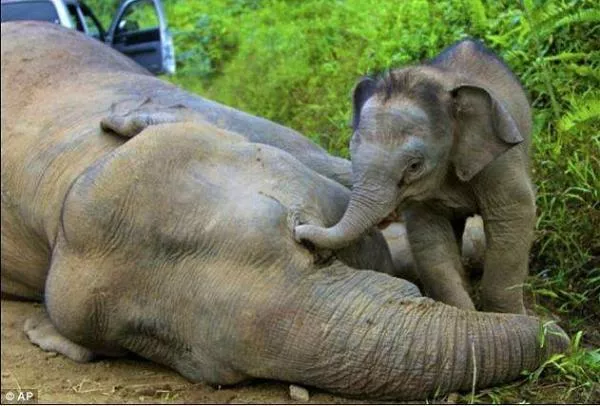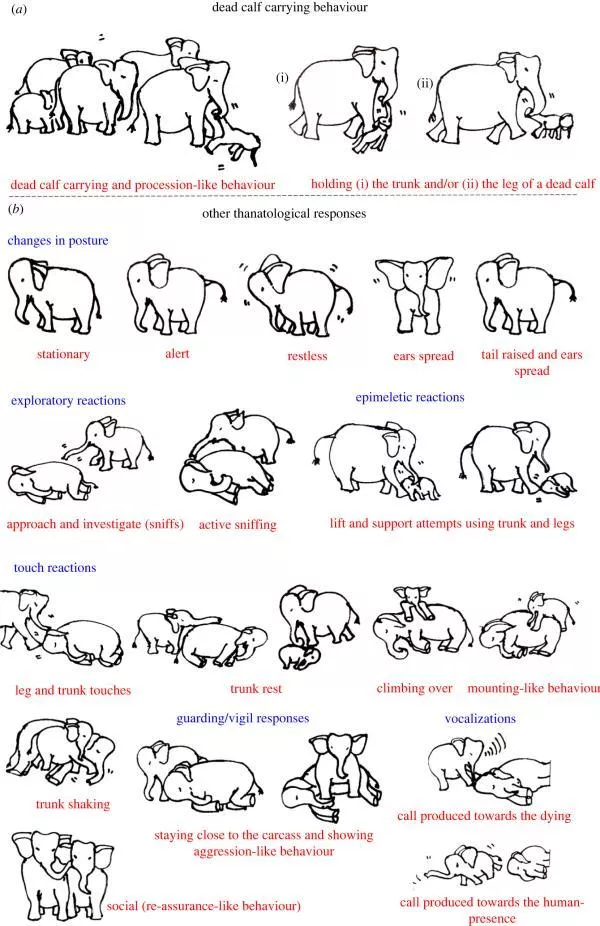In September 2018, villagers recorded a video of a besieged Asian elephant trying to nudge the body of a dead calf near tumku, India. The mother elephant's ears trembled in pain. For more than 24 hours, she kept pushing the inanimate body with her nose and feet. Finally, 12 adult elephants gathered around the dead baby elephant as if comforting the mother.

In Malaysia, a three month old Asian elephant tries to wake up its dead mother
In the dense jungles of South Asia, this seemingly mourning performance of Asian elephants is extremely difficult to find - let alone study. But now, thanks to dozens of videos on social networking site youtube, scientists have finally got the data they need to analyze the sad performance of these elusive thick skinned animals. Through the study of the video, they found some surprises.
Conservation biologist sanjeeta Sharma pokharel spent four years in the wild in India, but only once observed the response of an Asian elephant to the death of another elephant. Even her colleagues who have spent decades studying Asian elephants in the jungle have seen this "death behavior" only a few times. So pokharel and her team at the center for Ecological Sciences of the Indian Academy of Sciences turned to YouTube for help.
The researchers entered the search terms "Asian elephant death" and "elephant response to death" on the website. Finally, they collected 39 videos that captured the "death behavior" of 24 Asian elephants between 2010 and 2021.
These videos record several fascinating scenes. The research team wrote in a paper published in the Royal Society open science on May 18 that these scenes include an elephant patting a deceased family member with its trunk or trying to wake it up by kicking the deceased and gathering near the deceased's body like a night watchman.
Some videos also capture rare behaviors of elephants that have never been described in detail. In some video clips, adult elephants tap their friends who are still alive on the head with their trunks; In another clip, a baby elephant nestles next to her dying mother as she sinks into the thick mud. Five videos show adult females picking up dead calves with their noses and taking them through the forest for days or even weeks.

In the research video, the elephant picks up the dead baby elephant with its trunk and walks through the jungle
"Online [videos] like this provide an excellent opportunity to observe the rare behavior of elephants," said Lindsay Murray, a researcher in animal psychology at the University of Chester, who was not involved in the work. Murray studies how death affects the character of surviving Asian elephants at Chester Zoo. During the epidemic, she uses the zoo's webcam and online video to remotely study animal behavior.
Nowadays, this research method is called iecology by some scientists, that is, using multi-source videos and archives to learn more about animal behavior and ecology, which has also become a new research trend. For example, researchers used YouTube videos to study the behavioral differences between urban squirrels and forest squirrels, and how drones interfere with the behavior of wild animals such as albatrosses and flamingos.
These newly recorded behaviors of Asian elephants - including carrying dead larvae - have been observed in African elephants, chimpanzees, giraffes and dolphins. But scientists do not know whether this behavior represents human sadness or mourning.
In human understanding of death, death usually includes factors such as "inevitability" (all life forms will die), "Nonfunctionality" (dead life cannot be perceived or felt), "irreversibility" (dead creatures cannot be resurrected) and "causality" (cessation of biological function). In recent years, the study of comparative death has challenged the popular view that "only humans understand death", suggesting that different animal groups have a certain degree of death consciousness.
According to the newly published paper, non-human animals show significantly different responses to the death of the same animal. The most common reactions are direct reactions, such as touching, sniffing, dragging or handling the body; In mammals, this can last for minutes, weeks or even months. Some "secondary" reactions are also recorded, such as guarding, guarding, gathering, making various sounds, avoiding and attacking corpses or bystanders.
Some mammalian species, such as long nosed animals, live in complex social relationships, have strong social connections between relatives, have higher cognitive ability, and may show greater interest in dead peers. Previous studies on the African elephant (Loxodonta africana) have shown that African elephants have a strong interest in dead homologous animals. They will repeatedly visit or touch the dead, and show greater curiosity about their dead compatriots than heterogeneous animals.

The researchers documented the behavior of elephants in the face of the death of their compatriots
Pokharel, who currently works at the Smithsonian Institute for conservation biology, believes that this mourning emotion is possible in animals. "As a person, when I see this response from an elephant, I think it's associated with sad emotions," she said. "But as scientists, we need to prove it."
Shermin de Silva, a conservation biologist and director of the Udawalawe elephant research project in Sri Lanka, is convinced. "It's hard not to call such behavior sadness," said de Silva, who was not involved in the new work. "Such research can help bridge the emotional gap between humans and other species." De Silva said.